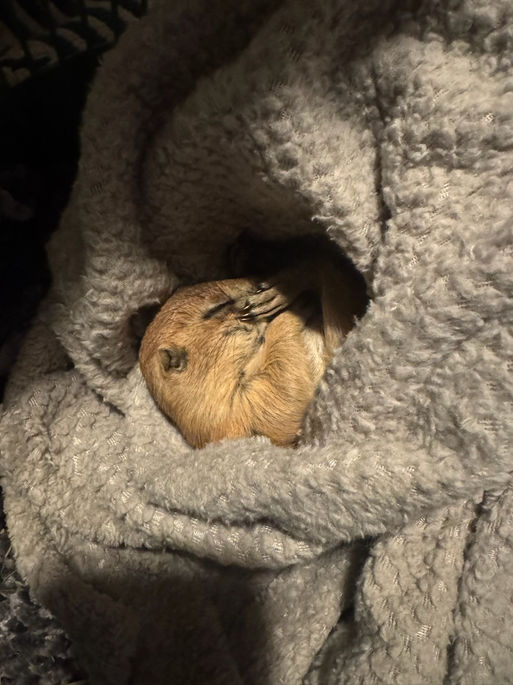

Thistle and Foxtail
Thistle and Foxtail were orphans in Texas when their underground Prairie dog town was destroyed and replaced with a housing tract. They arrived as youngsters although Foxtail was much larger so we don't think they are from the same litter. Their favorite foods are wild grasses that we pick for them in the yard and monkey chow. When they see us humans they get so excited that they rise up,"bark", then fall over backwards!
One of the interesting things about Prairie dogs is that they don’t reproduce in human care. All individuals that come to live with people are taken from the wild. Prairie dogs often have a bad deal out there in nature as they are considered pests and thousands are routinely destroyed.
These little darlings came from a group of caring individuals who rescue Prairie dogs in the wild. In fact, they attempt to relocate entire towns of these social rodents when their homes are to be replaced with shopping malls or housing tracts. This is no easy feat as some Prairie dog towns are as big as cities. In fact, there was one discovered in Texas that was the size of the state of Rhode Island!! In this process, some of the little animals get left behind so if possible they are scooped up and sold to people as pets where it is permitted or sent to wildlife centers like Wildworks where they can serve as educational ambassadors for their lifetimes.
There is a lot to learn and teach about Prairie dogs so here are some facts to get you started.
In the grasslands across the central and western United States, their intricate underground colonies—called prairie dog towns—create shelter for jackrabbits, toads, and rattlesnakes. The bare patches of ground created by their grazing and burrowing attract certain insects that feed a variety of birds. And prairie dogs themselves are a key food source for everything from coyotes to hawks to endangered black-footed ferrets.
They live in tight-knit family groups called coteries. The average coterie tends to have one or two breeding males, several breeding females, and the females’ new pups. Males tend to jump from coterie to coterie—but the females stick together for life.
They’re tough. Prairie dogs may look cute and cuddly , but in reality, they’re fast, skilled fighters armed with sharp claws and powerful teeth. It takes a while for black-footed ferrets to learn how to catch them. Prairie dogs fight back.
Their vocabulary is more advanced than any other animal language that’s been decoded To a human ear, prairie dogs’ squeaky calls sound simple and repetitive, but recent research has found that those calls can convey incredibly descriptive details. Prairie dogs can alert one another, for example, that there’s not just a human approaching their burrows, but a tall human wearing the color blue. Wow!
Their historical range has shrunk by more than 95% there used to be hundreds of millions of prairie dogs in North America. European settlers traveling through the West wrote about passing through massive prairie dog colonies, some of which extended for miles. But over time, their range has shrunk to less than 5% of its original extent due to a host of pressures, including habitat encroachment by humans.
Prairie Dogs







